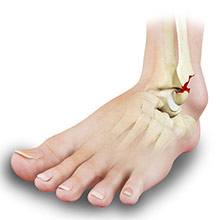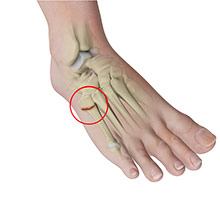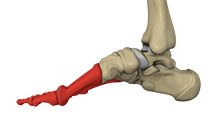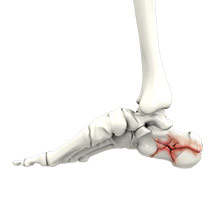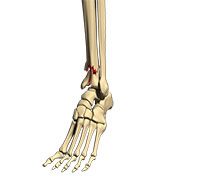Foot & Ankle
The foot and ankle in the human body work together to provide balance, stability, movement, and Propulsion.
This complex anatomy consists of:
- 26 bones
- 33 joints
- Muscles
- Tendons
- Ligaments
- Blood vessels, nerves, and soft tissue
Ankle Fractures
The ankle joint is composed of three bones: the tibia, fibula, and talus which are articulated together. The ends of the fibula and tibia (lower leg bones) form the inner and outer malleolus, which are the bony protrusions of the ankle joint that you can feel and see on either side of the ankle. The joint is protected by a fibrous membrane called a joint capsule, and filled with synovial fluid to enable smooth movement.
Foot Fracture
The hind foot is separated from the midfoot by the mediotarsal joint and the midfoot is separated from the forefoot by the lisfranc joint. Muscles, tendons and ligaments support the bones and joints of the feet enabling them to withstand the entire body’s weight while walking, running and jumping. Despite this, trauma and stress can cause fractures in the foot.
Lisfranc (Midfoot) Fracture
Tarsometatarsal joint refers to the region found in the middle of the foot. It is also called as Lisfranc joints. It is a junction between the tarsal bones (group of seven articulating bones in the foot) and metatarsal bones (a group of five long bones in the foot). A deformity in the tarsometatarsal region can be due to arthritis and traumatic motor accidents.
Stress Fractures of The Foot & Ankle
A stress fracture is described as a small crack in the bone which occurs from an overuse injury of a bone. It commonly develops in the weight bearing bones of the lower leg and foot. When the muscles of the foot are overworked, or stressed, they are unable to absorb the stress and when this happens the muscles transfer the stress to the bone which results in stress fracture.
Talus Fractures
The talus is a small bone at the ankle joint that connects the heel bone and the two bones of the lower leg, enabling the up and down movement of the foot. Fractures in the talus bone may occur due to a fall from great heights, motor vehicle accidents or twisting of the ankle. The symptoms include severe ankle pain, inability to walk, swelling and tenderness.
Toe & Forefoot Fractures
The forefoot is the front of the foot that includes the toes. Fractures occurring in this part of the foot are painful but very often not disabling. There are 2 types of fractures namely, traumatic fracture and stress fracture. Traumatic fractures occur when there is a direct impact of your foot on a hard surface. Stress fractures are tiny hair line cracks in the bone, most commonly caused due to repeated stress. The symptoms of toe and forefoot fractures include pain, bruising, swelling and inability to walk.
Calcaneus Fracture
The calcaneus or heel bone is a large bone found on the rear part of the foot. The calcaneus connects with the talus and cuboid bones to form the subtalar joint of the foot. A fracture is a break in a bone from trauma or various disease conditions. The types of fracture to the calcaneous depend on the severity and include stable fractures, displaced fractures, open fractures, closed fractures and comminuted fractures.
Pilon Fractures
The tibia and fibula are long shin bones, which articulate with the thigh bone on one end and ankle joint at the lower end. The part of the tibia that articulates with the talus (ankle bone) is called the tibial plafond or pilon. Fractures of the tibial plafond are rare, occurring because of a fall from a height or a motor vehicle accident that forces the ankle up against the tibia, often causing the bone to shatter. The fracture is often accompanied by damage to soft tissue, articular cartilage and underlying bone, which can lead to post-traumatic arthritis.
Shinbone Fracture
The tibia or shin bone is a major bone of the leg which connects the knee to the ankle. A fracture or break in the upper part of the tibia is known as a proximal tibial fracture and commonly occurs just below the knee joint. The knee joint is the largest weight bearing joint of the body, where the lower end of the femur or thigh bone articulates with the tibial plateau. The upper fourth of the tibia constitutes the proximal part and is composed of cancellous bone.

